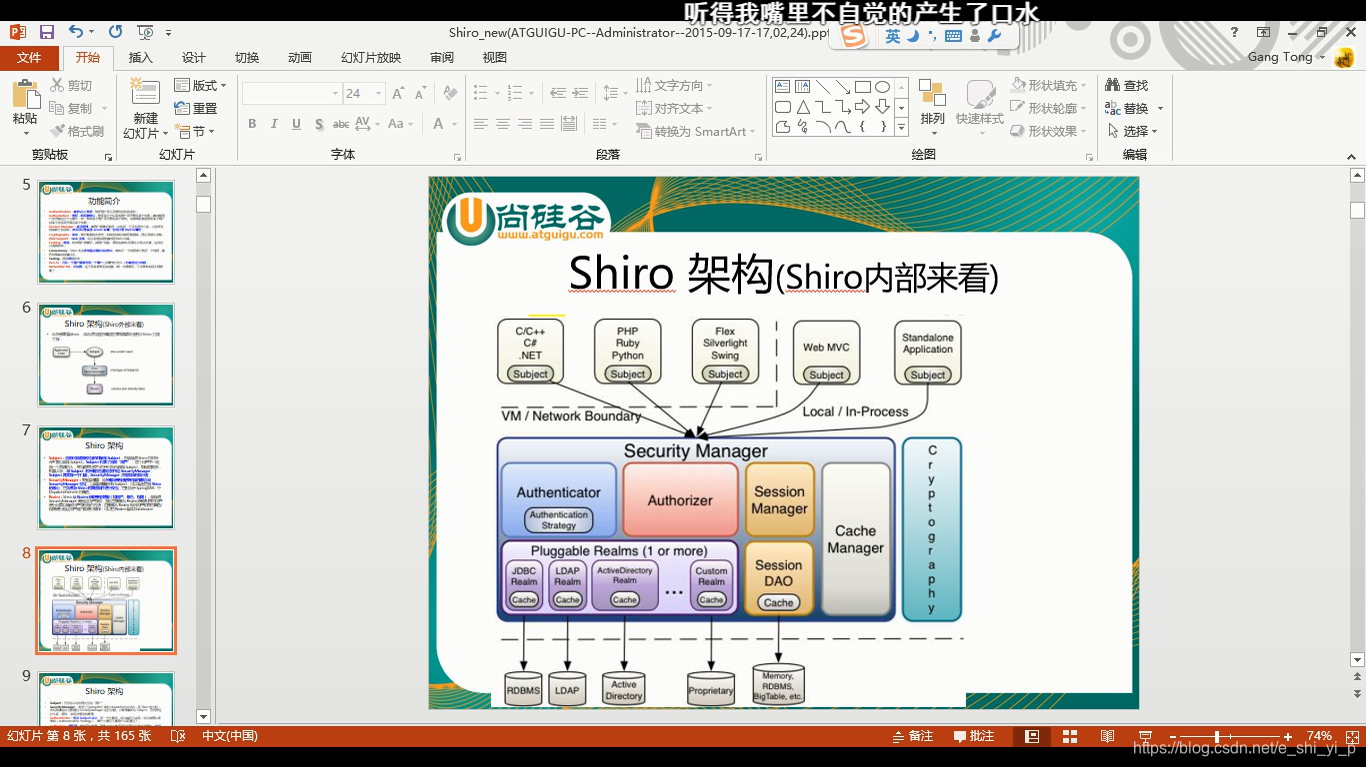shiro許可權框架__由淺入深 1
阿新 • • 發佈:2019-01-05
1、實現思路:工廠啟動時載入 .ini檔案許可權、使用者、角色資訊到一個集合中
2、通過 工廠獲取 SecurityManager 元件
3、通過 SecurityUtils.getSubject(); 獲取使用者元件
Subject:應用程式碼直接互動的物件是 Subject,也就是說 Shiro 的對外API 核心就是 Subject
4、Subject 中獲取session
5、subject 是操作入口 currentUser.isAuthenticated() 認證
currentUser.login(token) 登入\currentUser.hasRole(“schwartz”) 角色
currentUser.isPermitted(“user:delete:zhangsan”) 許可權
currentUser.logout(); 退出登入
SecurityManager:安全管理器;即所有與安全有關的操作都會與SecurityManager 互動;且其管理著所有 Subject;可以看出它是 Shiro的核心,
它負責與 Shiro 的其他元件進行互動,它相當於 SpringMVC 中DispatcherServlet 的角色(任務排程中心)、
SecurityManager中的元件_____Session Manager:會話管理,即使用者登入後就是一次會話,在沒有退出之前,它的所有資訊都在會話中即使用者登入後就是一次會話,在沒有退出之前,它的所有資訊都在會話中
shiro.ini 檔案配置 [users] # user 'root' with password 'secret' and the 'admin' role root = secret, admin # user 'guest' with the password 'guest' and the 'guest' role guest = guest, guest presidentskroob = 12345, president # user 'darkhelmet' with password 'ludicrousspeed' and roles 'darklord' and 'schwartz' darkhelmet = ludicrousspeed, darklord, schwartz # user 'lonestarr' with password 'vespa' and roles 'goodguy' and 'schwartz' lonestarr = vespa, goodguy, schwartz #使用者 密碼 角色1,角色2 # ----------------------------------------------------------------------------- # Roles with assigned permissions [roles] #針對上面的角色 有什麼許可權呢,可以做什麼 有什麼權利 # 'admin' role has all permissions, indicated by the wildcard '*' admin = * # The 'schwartz' role can do anything (*) with any lightsaber: schwartz = lightsaber:* goodguy = user:delete:zhangsan

public class Quickstart { private static final transient Logger log = LoggerFactory.getLogger(Quickstart.class); public static void main(String[] args) { Factory<SecurityManager> factory = new IniSecurityManagerFactory("classpath:shiro.ini"); SecurityManager securityManager = factory.getInstance(); SecurityUtils.setSecurityManager(securityManager); // Now that a simple Shiro environment is set up, let's see what you can do: // get the currently executing user: // 獲取當前的 Subject. 呼叫 SecurityUtils.getSubject(); Subject currentUser = SecurityUtils.getSubject(); // Do some stuff with a Session (no need for a web or EJB container!!!) // 測試使用 Session // 獲取 Session: Subject#getSession() Session session = currentUser.getSession(); session.setAttribute("someKey", "aValue"); String value = (String) session.getAttribute("someKey"); if (value.equals("aValue")) { log.info("---> Retrieved the correct value! [" + value + "]"); } // let's login the current user so we can check against roles and permissions: // 測試當前的使用者是否已經被認證. 即是否已經登入. // 調動 Subject 的 isAuthenticated() if (!currentUser.isAuthenticated()) { // 把使用者名稱和密碼封裝為 UsernamePasswordToken 物件 UsernamePasswordToken token = new UsernamePasswordToken("lonestarr", "vespa"); // rememberme token.setRememberMe(true); try { // 執行登入. currentUser.login(token); } // 若沒有指定的賬戶, 則 shiro 將會丟擲 UnknownAccountException 異常. catch (UnknownAccountException uae) { log.info("----> There is no user with username of " + token.getPrincipal()); return; } // 若賬戶存在, 但密碼不匹配, 則 shiro 會丟擲 IncorrectCredentialsException 異常。 catch (IncorrectCredentialsException ice) { log.info("----> Password for account " + token.getPrincipal() + " was incorrect!"); return; } // 使用者被鎖定的異常 LockedAccountException catch (LockedAccountException lae) { log.info("The account for username " + token.getPrincipal() + " is locked. " + "Please contact your administrator to unlock it."); } // ... catch more exceptions here (maybe custom ones specific to your application? // 所有認證時異常的父類. catch (AuthenticationException ae) { //unexpected condition? error? } } //say who they are: //print their identifying principal (in this case, a username): log.info("----> User [" + currentUser.getPrincipal() + "] logged in successfully."); //test a role: // 測試是否有某一個角色. 呼叫 Subject 的 hasRole 方法. if (currentUser.hasRole("schwartz")) { log.info("----> May the Schwartz be with you!"); } else { log.info("----> Hello, mere mortal."); return; } //test a typed permission (not instance-level) // 測試使用者是否具備某一個行為. 呼叫 Subject 的 isPermitted() 方法。 if (currentUser.isPermitted("lightsaber:weild")) { log.info("----> You may use a lightsaber ring. Use it wisely."); } else { log.info("Sorry, lightsaber rings are for schwartz masters only."); } //a (very powerful) Instance Level permission: // 測試使用者是否具備某一個行為. if (currentUser.isPermitted("user:delete:zhangsan")) { log.info("----> You are permitted to 'drive' the winnebago with license plate (id) 'eagle5'. " + "Here are the keys - have fun!"); } else { log.info("Sorry, you aren't allowed to drive the 'eagle5' winnebago!"); } //all done - log out! // 執行登出. 呼叫 Subject 的 Logout() 方法. System.out.println("---->" + currentUser.isAuthenticated()); currentUser.logout(); System.out.println("---->" + currentUser.isAuthenticated()); System.exit(0); }
借鑑:https://blog.csdn.net/qq_20641565/article/details/78772938
由上述流程可以推測,spring整合shiro後流程如下:
spring容器\bean工廠啟動時
載入ShiroFilter 的 bean 中資訊進入map
認證、授權 bean__繼承_AuthorizingRealm 得到許可權set<string>
web.xml中對每一次請求進行攔截
//如果沒有認證__會跳轉到自定義登入頁、那些訪問資源可以直接訪問
//每一次請求時會比對
//登入只會執行一次
//許可權認證__每一次請求都會執行、得到許可權set 根據頁面的shiro標籤實現顯示、隱藏-------------
